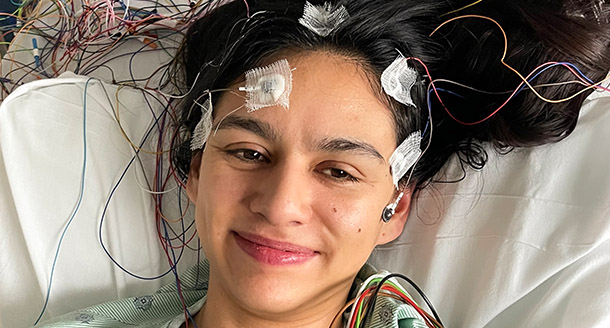Overview
Astrocytoma, IDH-mutant, is an invasive tumor with poorly defined boundaries that is derived from astrocytes. Astrocytes are a type of star-shaped glial cell in the brain and spinal cord. Glial cells serve to provide the “glue” to maintain the structure of the brain and spinal cord as well as maintain the environment around the neurons to enable optimal brain function. As such, astrocytomas are also part of a group of tumors called gliomas, and they can be either grouped with low-grade gliomas (LGG) or high-grade gliomas (HGG), depending on their WHO grade. Astrocytoma, IDH-mutant, can occur in any part of the central nervous system (CNS), but it is usually located near or within the frontal lobes of the brain. Signs and symptoms largely depend on the tumor’s location. Seizures are a common presenting symptom. Subtle neurological changes such as speech or language difficulties, vision changes, and sensory changes can be present before diagnosis, and with tumors in the frontal lobe, changes in behavior and personality can be present months to years before diagnosis.
2021 WHO CNS Grade
A tumor grade describes how normal or abnormal tumor cells appear under a microscope. In lower grade tumors like grade 1, the cells look close to normal. In higher grade tumors like grade 4, the cells look more abnormal. Astrocytoma, IDH-mutant is considered grade 2, 3, or 4.
Statistics
Please note that these statistics look at diagnoses from 2017 to 2021 which are the most currently available at this time. In 2021, however, the diagnostic criteria for astrocytoma and glioblastoma changed in the WHO classifications. These statistics represent the previous diagnostic criteria for diffuse astrocytoma and anaplastic astrocytoma, which are no longer diagnoses per the WHO classifications, and they do not necessarily represent astrocytoma, IDH-mutant.
- Percent of All Brain and Other CNS Tumors: 1.6% (diffuse astrocytoma); 1.3% (anaplastic astrocytoma)
- Average Annual Age-Adjusted Incidence Rate: 0.45 per 100,000 (diffuse astrocytoma); 0.35 per 100,000 (anaplastic astrocytoma)
- Median Age at Diagnosis: 45 years (diffuse astrocytoma); 52 (anaplastic astrocytoma)
Survival
Survival rates compare the percentage of people living with a particular diagnosis at a particular point in time compared to the general population.
Please note that these statistics look at diagnoses from 2017 to 2021 which are the most currently available at this time. In 2021, however, the diagnostic criteria for astrocytoma and glioblastoma changed in the WHO classifications. These statistics represent the previous diagnostic criteria for diffuse astrocytoma and anaplastic astrocytoma, which are no longer diagnoses per the WHO classifications, and they do not necessarily represent astrocytoma, IDH-mutant.
- One-Year Relative Survival Rate: 77.2% (diffuse astrocytoma); 68.4% (anaplastic astrocytoma)
- Five-Year Relative Survival Rate: 54.0% (diffuse astrocytoma): 33.0% (anaplastic astrocytoma)
- Ten-Year Relative Survival Rate: 43.6% (diffuse astrocytoma); 24.2% (anaplastic astrocytoma)
Treatment Options
Every person living with a brain or CNS tumor is unique. If you have been diagnosed with a brain or CNS tumor and would like to better understand your treatment options, it is important to work with your health care team to decide the best course of treatment for you. You may also consider getting a second opinion or reaching out to our Personalized Support and Navigation team to learn more.



